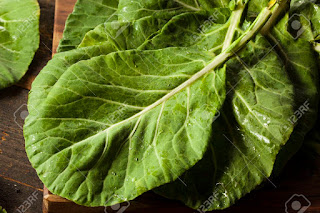COLLARD GREENS
Most Americans associate collard greens
with the south where they are very popular.
There are annual festivals in cities like Atlanta and Savannah. Collard greens are the official state
vegetable of South Carolina. It's impossible to imagine southern cuisine
without collards, grits or barbecue.
Research indicates that collards
originated from wild cabbages found in Asia where it was consumed by humans
before recorded time.
From Asia it spread to Europe where it was grown by the
Greeks and Romans in home gardens and eventually became established
throughout
Europe.
Early European settlers brought collars to America by ship. After their
arrival, African slaves added their own cooking styles which has become an
important part of our traditional American cuisine today.
Nowadays, collard greens are widely
consumed worldwide in many counties, including India and Brazil, where it is an
important ingredient in national dishes. Collards are included in New Year's
celebrations and eaten for good luck.
Collard greens are a leafy vegetable from
the same family as cabbage and broccoli. Collards are a cool season vegetable
that when planted in September can be harvested into early winter. Resistant to
frost, they are one of the first crops that can also be planted in early
spring, two to four weeks before the last frost. Many people claim that frost
helps increase the flavor of this vegetable.
Closely related to kale, collard greens
require similar care. A moist soil, rich with compost that is not permitted to
dry out and receives full sun.
When started from seed in late August or
September, follow the directions on the label for basic care of your seedlings.
Collards require one inch of water a week. They are light feeders and when
planted in soil enriched with compost do not require additional
fertilizer.
Collard greens are considered a
'super-food' with impressive health benefits. They are known to purify the
liver and eliminate toxins from the body. They supply vitamins and minerals
that have many positive effects on the body. They even supply antioxidants
which offset early aging, promote hair growth, and help prevent disease such as
diabetes.
Too numerous to write here, more information on the health benefits
of collard greens can be found online and are well worth researching. Sadly
many people over boil these think greens which leaches most of the nutrients
out.
Other cole crops (cold weather crops)
that can be planted now include cabbage, broccoli, Brussels sprouts,
cauliflower and kale.
If you would like a quick harvest autumn
vegetable, you can plant lettuce. It grows fast and will
last until the first frost.
Happy Autumn Gardening,
James
James





